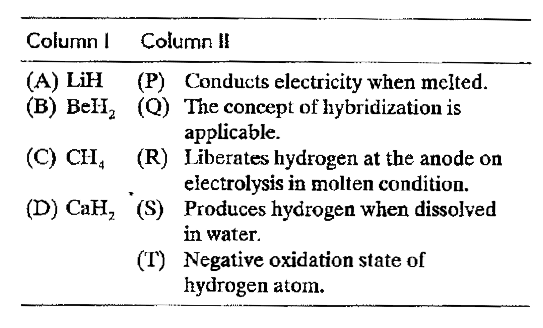Metals of groups 7, 8 and 9 do not form metallic hydrides. This is termed as
A
hydride gap
B
hydride shift
C
dehydride
D
anhydride
Text Solution
The correct Answer is:A
The region of the periodic table from groups 7 to 9 is referred as hydride gap because these metals do not form hydrides.
|
Similar Questions
Knowledge Check
Be and Mg from amongst the p-block elements and most of the d-block elements give metallic or interstitial hydrides on reacting with hydrogen. The density of each compound is less than that of the metal itself and the properties are not much different from that of the metal. They give out hydrogen easily and are strong reducing agents. This suggests that hydrogen is present in the atomic state. these compounds are non-stoichiometric. the f-block elements (i.e., lanthanide and actinides) also form non-stoichiometric hydrides. These hydrides have lower densities than their respective metals. The metals of group 7,8 and 9 do not form hydrides. This region of the periodic table is called 'hydride gap'.
Interstitial hydride can not be used as,Astoring H2BCatalysts for hydrogenation reactionCRocket propellantDElectric conductorBe and Mg from amongst the p-block elements and most of the d-block elements give metallic or interstitial hydrides on reacting with hydrogen. The density of each compound is less than that of the metal itself and the properties are not much different from that of the metal. They give out hydrogen easily and are strong reducing agents. This suggests that hydrogen is present in the atomic state. these compounds are non-stoichiometric. the f-block elements (i.e., lanthanide and actinides) also form non-stoichiometric hydrides. These hydrides have lower densities than their respective metals. The metals of group 7,8 and 9 do not form hydrides. This region of the periodic table is called 'hydride gap'.
Which of the following has highest electrical conductance?ABeH2BMgH2CCaH2DZrH2Be and Mg from amongst the p-block elements and most of the d-block elements give metallic or interstitial hydrides on reacting with hydrogen. The density of each compound is less than that of the metal itself and the properties are not much different from that of the metal. They give out hydrogen easily and are strong reducing agents. This suggests that hydrogen is present in the atomic state. these compounds are non-stoichiometric. the f-block elements (i.e., lanthanide and actinides) also form non-stoichiometric hydrides. These hydrides have lower densities than their respective metals. The metals of group 7,8 and 9 do not form hydrides. This region of the periodic table is called 'hydride gap'.
Which type of hydride is formed by the element having atomic number, Z=43?Ametallic hydrideBSaline hydrideCCovalent hydrideDNo hydride
Match the metal hydrides with their properties.

View SolutionHydrogen reacts with strong metals to form metal hydrides.
View SolutionWhich metal does not form ionic hydride-
View SolutionIn group 6, only one metal forms hydride. This metal is
View SolutionIn group 6, only one metal forms hydride. This metal is
View Solution
